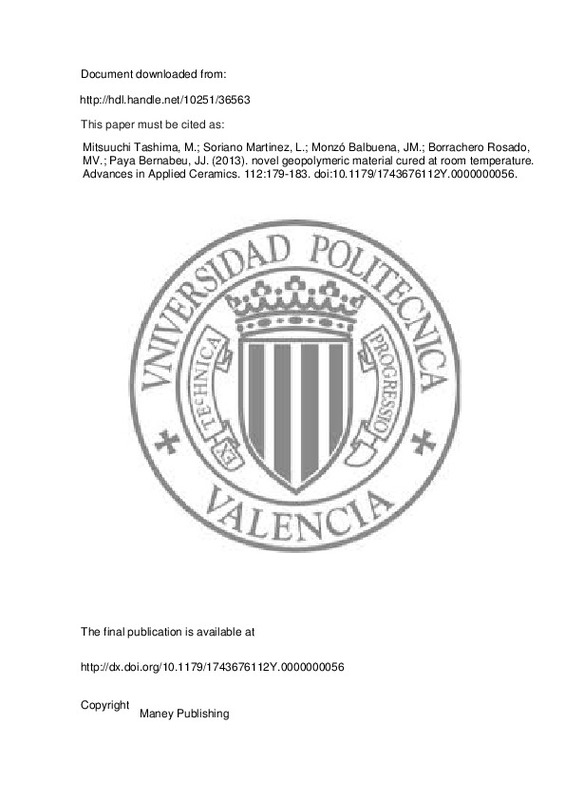JavaScript is disabled for your browser. Some features of this site may not work without it.
Buscar en RiuNet
Listar
Mi cuenta
Estadísticas
Ayuda RiuNet
Admin. UPV
novel geopolymeric material cured at room temperature
Mostrar el registro sencillo del ítem
Ficheros en el ítem
| dc.contributor.author | Mitsuuchi Tashima, Mauro
|
es_ES |
| dc.contributor.author | Soriano Martínez, Lourdes
|
es_ES |
| dc.contributor.author | Monzó Balbuena, José Mª
|
es_ES |
| dc.contributor.author | Borrachero Rosado, María Victoria
|
es_ES |
| dc.contributor.author | Paya Bernabeu, Jorge Juan
|
es_ES |
| dc.date.accessioned | 2014-03-21T11:34:21Z | |
| dc.date.issued | 2013-05 | |
| dc.identifier.issn | 1743-6753 | |
| dc.identifier.uri | http://hdl.handle.net/10251/36563 | |
| dc.description.abstract | [EN] Alkali activated binders are a new class of binding material with comparable or enhanced performance to Portland cement. These binding materials are obtained by a chemical reaction between an aluminosilicate material and a highly alkaline solution. In most cases, the setting hardening process of this binder is performed at high curing temperatures. In this paper, alkali activated mortars based on vitreous calcium aluminosilicate (VCAS) cured at room temperature are evaluated. Mechanical strength development and microstructural analysis (scanning electron microscopy, thermogravimetric analysis, X-ray diffraction and mercury intrusion porosimetry) of these materials are performed. Mortars yielded compressive strength ¡-89 MPa after 360 days. This is the first time that VCAS is used as aluminosilicate source material in the production of alkali activated mortars cured at room temperature. | es_ES |
| dc.description.sponsorship | The authors acknowledge the Ministerio de Ciencia e Innovacio´ n of the Spanish Government (projecto. BIA2011-26947) and the Vitrominerals company for supplying VCAS samples. | |
| dc.language | Inglés | es_ES |
| dc.publisher | Maney Publishing | es_ES |
| dc.relation.ispartof | Advances in Applied Ceramics | es_ES |
| dc.rights | Reserva de todos los derechos | es_ES |
| dc.subject | Alkali activated binder | es_ES |
| dc.subject | VCAS | es_ES |
| dc.subject | Room temperature | es_ES |
| dc.subject | Mechanical strength | es_ES |
| dc.subject.classification | INGENIERIA DE LA CONSTRUCCION | es_ES |
| dc.title | novel geopolymeric material cured at room temperature | es_ES |
| dc.type | Artículo | es_ES |
| dc.embargo.lift | 10000-01-01 | |
| dc.embargo.terms | forever | es_ES |
| dc.identifier.doi | 10.1179/1743676112Y.0000000056 | |
| dc.relation.projectID | info:eu-repo/grantAgreement/MICINN//BIA2011-26947/ES/REUTILIZACION DE RESIDUOS CERAMICOS Y DE DEMOLICION EN LA PREPARACION DE NUEVOS MATERIALES GEOPOLIMERICOS/ | es_ES |
| dc.rights.accessRights | Abierto | es_ES |
| dc.contributor.affiliation | Universitat Politècnica de València. Instituto de Ciencia y Tecnología del Hormigón - Institut de Ciència i Tecnologia del Formigó | es_ES |
| dc.contributor.affiliation | Universitat Politècnica de València. Departamento de Ingeniería de la Construcción y de Proyectos de Ingeniería Civil - Departament d'Enginyeria de la Construcció i de Projectes d'Enginyeria Civil | es_ES |
| dc.description.bibliographicCitation | Mitsuuchi Tashima, M.; Soriano Martínez, L.; Monzó Balbuena, JM.; Borrachero Rosado, MV.; Paya Bernabeu, JJ. (2013). novel geopolymeric material cured at room temperature. Advances in Applied Ceramics. 112:179-183. https://doi.org/10.1179/1743676112Y.0000000056 | es_ES |
| dc.description.accrualMethod | S | es_ES |
| dc.relation.publisherversion | http://dx.doi.org/10.1179/1743676112Y.0000000056 | es_ES |
| dc.description.upvformatpinicio | 179 | es_ES |
| dc.description.upvformatpfin | 183 | es_ES |
| dc.type.version | info:eu-repo/semantics/publishedVersion | es_ES |
| dc.description.volume | 112 | es_ES |
| dc.relation.senia | 257392 | |
| dc.contributor.funder | Ministerio de Ciencia e Innovación |







![[Cerrado]](/themes/UPV/images/candado.png)

